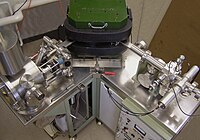
Photo from wikipedia
Stable isotope mixing models (SIMMs) are an important tool used to study species' trophic ecology. These models are dependent on, and sensitive to, the choice of trophic discrimination factors (TDF)… Click to show full abstract
Stable isotope mixing models (SIMMs) are an important tool used to study species' trophic ecology. These models are dependent on, and sensitive to, the choice of trophic discrimination factors (TDF) representing the offset in stable isotope delta values between a consumer and their food source when they are at equilibrium. Ideally, controlled feeding trials should be conducted to determine the appropriate TDF for each consumer, tissue type, food source, and isotope combination used in a study. In reality however, this is often not feasible nor practical. In the absence of species-specific information, many researchers either default to an average TDF value for the major taxonomic group of their consumer, or they choose the nearest phylogenetic neighbour for which a TDF is available. Here, we present the SIDER package for R, which uses a phylogenetic regression model based on a compiled dataset to impute (estimate) a TDF of a consumer. We apply information on the tissue type and feeding ecology of the consumer, all of which are known to affect TDFs, using Bayesian inference. Presently, our approach can estimate TDFs for two commonly used isotopes (nitrogen and carbon), for species of mammals and birds with or without previous TDF information. The estimated posterior probability provides both a mean and variance, reflecting the uncertainty of the estimate, and can be subsequently used in the current suite of SIMM software. SIDER allows users to place a greater degree of confidence on their choice of TDF and its associated uncertainty, thereby leading to more robust predictions about trophic relationships in cases where study-specific data from feeding trials is unavailable. The underlying database can be updated readily to incorporate more stable isotope tracers, replicates and taxonomic groups to further increase the confidence in dietary estimates from stable isotope mixing models, as this information becomes available.
Journal Title: Ecography
Year Published: 2018
Link to full text (if available)
Share on Social Media: Sign Up to like & get
recommendations!